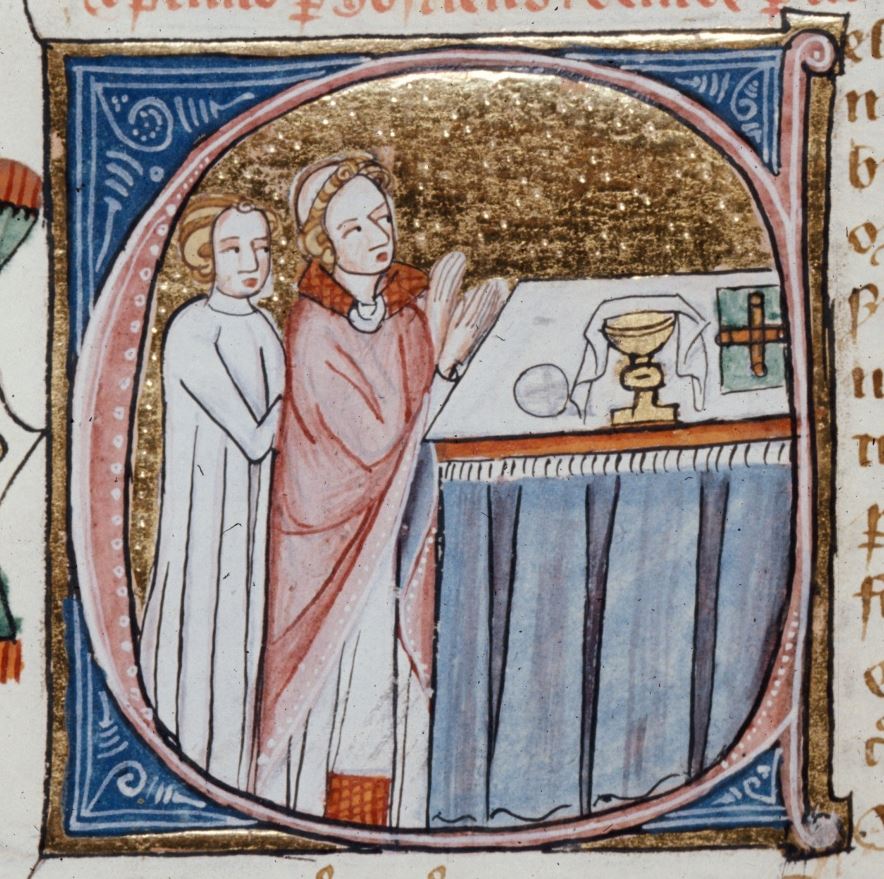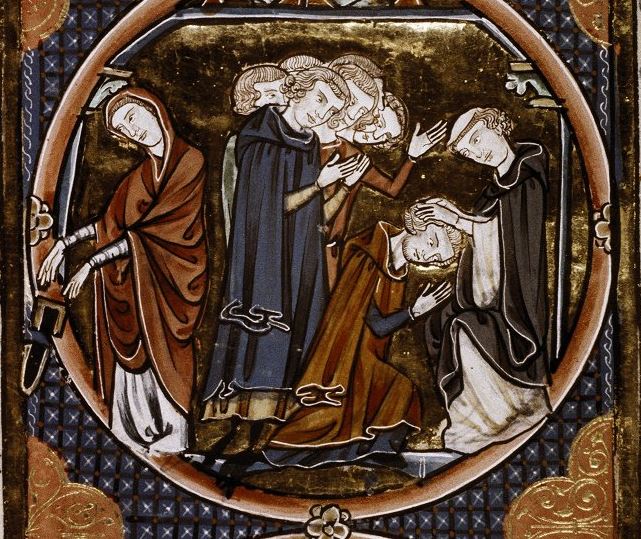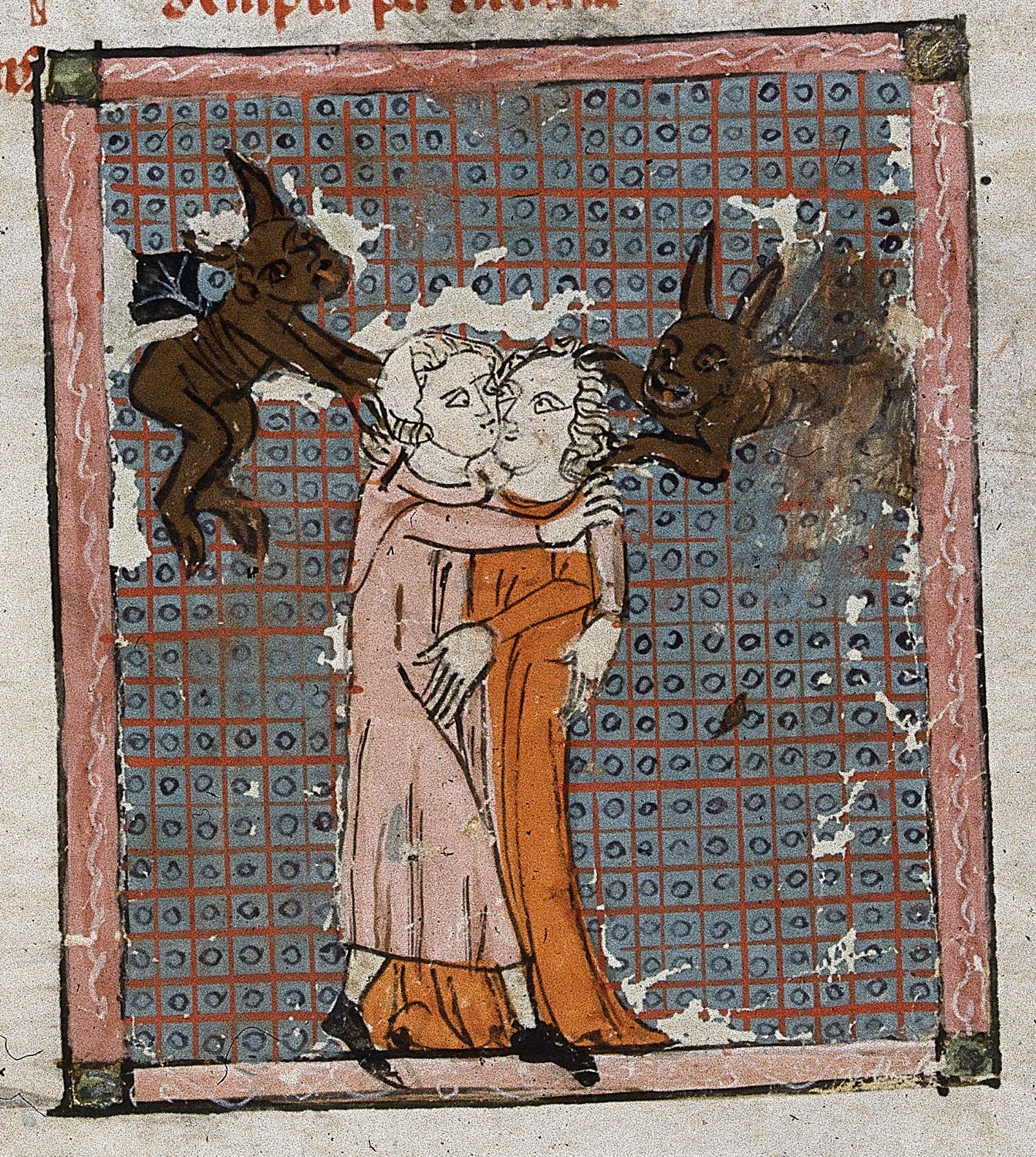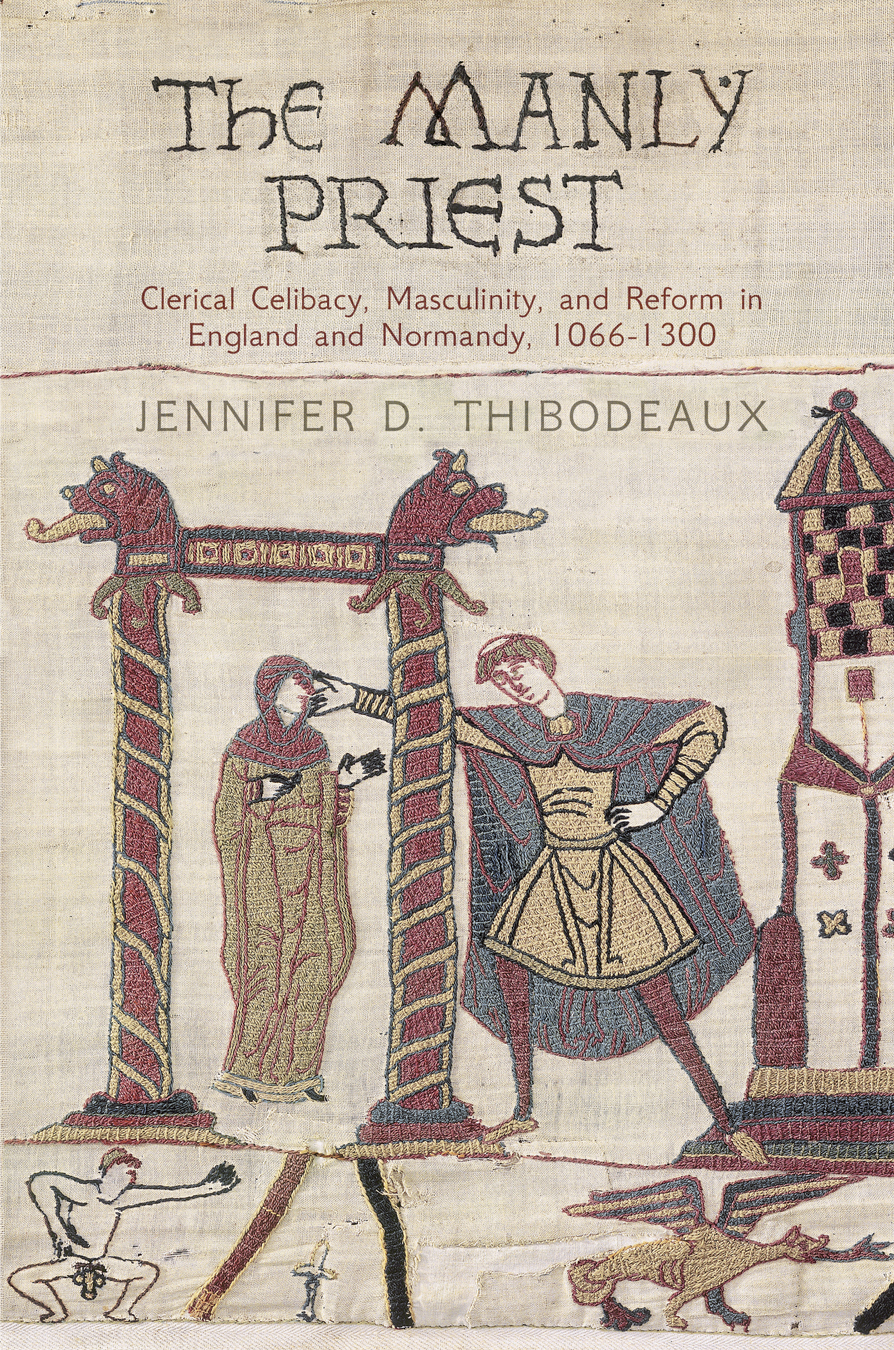Interview by Katherine Harvey
In The Manly Priest: Clerical Celibacy, Masculinity, and Reform in England and Normandy, 1066-1300, Jennifer Thibodeaux tells the story of the imposition of clerical celibacy in the Anglo-Norman realms. For much of the medieval period, priests in both England and Normandy were not only permitted to marry, but also to prepare their own sons for ecclesiastical careers. Then, in the late eleventh century, the Roman Catholic Church began to require its priests to remain celibate. Thibodeaux explores the wide-reaching consequences of this radical shift, focusing in particular on its consequences for clerical masculinity. Whilst the introduction of compulsory celibacy initially met with staunch resistance from married priests, it eventually became a clerical norm. In the process, a new model of clerical manliness was created.
Katherine Harvey: What motivated the 11/12/13th century drive towards universal celibacy?
Jennifer Thibodeaux: I don’t think there was one element which motivated the drive towards universal clerical celibacy. In fact, there were many elements which seemed to coalesce together at a certain moment in time, and together produced the eleventh-century reform movement of the Roman Church. Looking back at the earlier centuries of the Roman Church, there was always a certain amount of discomfort with priestly sexuality. Church councils in the fourth and fifth centuries tried to place restrictions on a priest’s sexuality by dictating that he live in continence with his wife, or by some interpretations, that he live in periodic continence with his wife. By the eleventh century, there was an increasing sacredness associated with the Eucharist, which made the continence of the priest all that more important to many. Peter Damian is famous for criticizing priests who rolled around in bed with their women, and then touched the altar and sacrament. Many were uncomfortable with this idea; we know that, from a theological perspective, a priest cannot contaminate the sacrament, but reformers repeatedly honed in on this possibility. Can a priest touch the most sacred Body of Christ, after having sexually touched his wife? The eleventh-century Roman Church was very much a monasticized one; we see the beginning of an exaltation of the monastic way of life, and the appointment of monks to higher positions, like bishop and pope. Since monks took a vow of chastity, they lived the ideal. And as they entered higher ecclesiastical offices, they took with them this ideal, which they then tried to enforce upon the parochial clergy.
KH: Why did a celibate man need to experience sexual desire and how could he act manfully? Why was physical castration not a good option for a priest? What was spiritual castration and how might it be achieved?
JT: Proponents of ascetic masculinity were well aware of the problems with glorifying the asexual man. This is perhaps the reason that the “soldier of Christ” ideology became so prominent in the eleventh century. If you read the saints’ lives from this time, you notice an intense glorification of the monastic life; monastic writers portrayed it as a masculinized life, so much so that even knights are converted to this path. Some suggest that the warrior motif presented in these stories was meant to not only encourage knights to enter the monastery, but also to make their transition to the ascetic life easier. With this in mind, a celibate man, or monk, or priest, needed to experience sexual desire because he needed to continually fight against his own desires. If he no longer experienced sexual desire, then he no longer struggled. Masculinity always needed to be re-asserted through some kind of conflict; this did not have to be a violent one, but something that provided a context for defining manliness. Ascetic masculinity was built on self-control. In order for one to conquer his sexual desires, one needed to experience sexual urges.
Physical castration would seem to be a solution for those pesky sexual urges, except that by removing the genitals, one would lose his claim on being a man. The early Church took up this question; should a Christian man be castrated as a solution to end sexual desire? The answer was no. In the Norman world, possession of male genitalia was key to male status. Normans struck back at their political enemies by castrating them; essentially, they deprived them of their masculinity. It was the only place in medieval Europe where castration was used as punishment for a non-sexual crime. Elsewhere in Europe, castration was used to punish rapists. Spiritual castration was available only by divine intervention. There were stories of “mystical castration” whereby a holy man conquered his sexual desires by a miracle, literally. These stories are a bit problematic for achieving manliness, since this kind of miracle ended the war against the flesh. There are not many of those stories, and I have to think that it did not become a popular motif precisely because it rendered a holy man completely asexual.
KH: What were the signs of effeminacy, and why did it pose such a threat to clerics?
JT: In the eleventh and twelfth centuries, religious writers noted the prevalence of “softened” men at the courts of Anglo-Norman kings. These men wore their hair in a female fashion, long and curling, walked with a delicate gait, and also were associated with sodomy. All of this behavior was associated with effeminacy, and clearly, this points to men acting like women. But, religious writers also defined effeminacy as an excessive love of, and domination by, women. In the Middle Ages, you could risk your manliness by acting like a woman, or by allowing a woman to dominate you. For clerics, this meant that they were often ridiculed by monastic writers for spending church revenue on luxurious clothing for their women. Clerics were also ridiculed for their inability to withstand sexual temptation.

KH: Can you explain how the church enforced clerical celibacy? How did the rise of clerical celibacy alter relations between different groups of clergymen—between clerical elites and their subordinates, and between monks and secular clergy?
JT: In the eleventh and twelfth centuries, the Church did not enforce clerical celibacy very well at all. At that point in the Middle Ages, bishops had little means of enforcement; they generally decreed laws at councils, and then either in person, or by proxy, sent those laws to synods, where the clergy of many parishes gathered together to hear the latest “news.” Anselm, as archbishop of Canterbury (1093-1109), held two councils to deliver and reinforce these laws requiring priests to separate from their wives. At the first council in 1102, he simply ordered that priests could not live with their wives. He thought, perhaps naively, that without cohabitation, priests would not be able to have sex with their wives. We find out from letters exchanged between the archbishop and one of his bishops that the priests simply moved their women to their neighbor’s houses. The culture of married clergy was so entrenched that it was likely impossible to find a priest who did not have a wife or female partner. How do you patrol morality when everyone is guilty of the same sin? There was undoubtedly a large amount of hostility directed from priests towards these reformers, almost all of whom were monks who never married and would never marry.
KH: How much resistance was there to these new restrictions on clerical sexuality? What arguments did opponents of sacerdotal celibacy use to defend the right of clergymen to marry? Why were they ultimately defeated?
JT: Imagine that you are living the very same life your father and grandfather and great-grandfather lived. You marry, have children, and minister to your local community. One day, a bishop or archdeacon comes to your village, and announces that you no longer have a legitimate wife or children, and that you must toss them out to the road. Imagine that the person making this pronouncement is a monk, a man who has never married. I think that in some cases, priests just shrugged it off, went back to their homes, and continued with their lives, as they always had. In other cases, we hear of a very active and hostile resistance. The chronicler Orderic Vitalis tells us of two stories, one in which a synod of priests threw stones at their bishop shortly after this announcement; and in the other, priests are incredulous and aghast at such a ridiculous decree. Clerical writers who defended a priest’s right to marry relied upon historical precedent and appeals to morality. Some pointed out that many bishops and even popes in the early Church had married. They also suggested that if they were not allowed to have a wife, priests might instead be driven to fornication, and other sexual crimes, such as sodomy. In some of the more hostile polemics, writers suggested that monks were driving this movement (as they were) because they were sodomites. Finally, we see these writers raised the question of masculine honor as a factor in retaining their marriages.
KH: How did the rise of clerical celibacy influence contemporary attitudes to/discussions of sodomy?
JT: This is a very interesting question. Some clerical writers, such as Serlo of Bayeux, definitely associated sodomy with monasticism, and particularly insinuated that reformers were sodomites who went unpunished while they punished lawfully married priests. We know that legislation in England and Normandy focused overwhelmingly on outlawing clerical marriage. We also see that sodomy, seen as a heinous offense by many chroniclers and their contemporaries, is absent in conciliar legislation. The writer William of Malmesbury asserted that originally there were laws against sodomy passed at the Council of Westminster (1102), but that for reasons unknown, Anselm did not promulgate them. So you must imagine what married priests were thinking, when they saw homoerotic behavior at court and in the monasteries go unpunished, while their marriages were decreed unlawful. The late John Boswell noted this exclusion, and argued it was evidence that the early medieval Church tacitly accepted homosexuality. The Boswell thesis is controversial, but I do think that it is notable that at a time when war was waged over priestly marriage that male homoeroticism was not similarly punished.
KH: How did the position of clerical sons change during this period? Why were they so problematic for proponents of clerical celibacy?
JT: To put it simply, clerical sons (sons of priests who were themselves priests/clerics) were visible reminders of their fathers’ sexual incontinence. Many clerics and reformers believed that clerical sons could not be punished for their fathers’ immorality. But, since priestly fathers tended to pass down church benefices to their sons, this set up a cycle of hereditary benefices, which could result in the alienation of church property and revenues. In fact, this was one of the factors contributing to the campaign for a celibate priesthood. Very early church councils had recommended that clerical sons could only be ordained if they were cloistered monks. The assumption here was that a son who was a cloistered monk would not alienate church revenue because he would (presumably) remain chaste. In Normandy, it was expected that a priest’s son would be ordained and assume his father’s position. All men, with the exception of monks, would pass their occupation or vocation to their sons. Priests were no different. There was legislation passed in England which specified that a clerical son could be ordained and assume a church benefice, but only if succession between father and son was interrupted. There had to be a third-party to break the cycle of hereditary succession.
KH: You identify a shift in the ecclesiastical agenda around the time of the Fourth Lateran Council; the Anglo-Norman reforms were “almost exclusively devoted to the problems of clerical sexuality,” whereas their thirteenth-century counterparts promoted a broader model of religious manliness. What was this new model and how/why did it develop?
JT: Lateran IV (1215) held by Pope Innocent III, the original papal “monarch,” was definitely a watershed moment in the history of the medieval Church. All of the objectives of reform were presented along with actual mandates for carrying out those reforms, such as periodic visitation of parishes by bishops. The Church was creating a set of hard guidelines for clerical morality, which included standards for clerical appearance, and prohibitions on other typically masculine forms of behavior and activity, like gambling, tavern-frequenting, etc. So why were these concerns not expressed earlier in the eleventh and twelfth century church councils? I think the eradication of clerical marriage was an attempt to impose a monastic masculinity, or what I call “the manly priest model” upon the priesthood; obviously, the primary distinction between a monk and a priest is that the latter was traditionally married. But once reformers succeeded in eliminating, in theory, clerical marriage, they found that priests did not embrace the ideal of the “manly priest.” In fact, marriage was but one part of a priest’s gender identity. He still went to taverns, drank excessively, and sometimes gambled away his clerical robe. Lateran IV, then, was an all-inclusive attempt to formally monasticize the priesthood and to separate them from the laity, while elevating them in status. From the perspective of the Church, you cannot be an effective minister, judging parishioners’ sins, if you get drunk every night in the taverns. The Church needed priests to be spiritual leaders, not “one of the boys.” Meanwhile, a priest who lived up to this intensive model of clerical masculinity found himself somewhat socially isolated from his peers, alone without a woman or children, and forced to hold himself to a higher moral state. In an age when community was everything, that must have been quite difficult to attain. Monks were never socially isolated from their peers; instead, the nature of monasticism dictated that they live in a community together. Most monks, then, could attain the high spiritual standard expected of them, while cohabitating with their peers.

KH: The last chapter of the book opens with the case of a Norman priest who was “ill famed of incontinence with a stone-cutter’s wife, who is said to have borne him a child…he is nonresident, plays ball, and rides about in an open cape…” How did the church deal with men like this? Were the parish clergy ever effectively reformed?
JT: That case came from the register of the archbishop of Rouen, Odo Rigaldus (also known as Eudes Rigaud). Odo was a zealous reformer, and although quite advanced in age, he made the rounds of his Norman parishes probably twice. He recorded the behavior of his parish clergy in his register, making this a great source for examining clerical behavior in the mid-thirteenth century. Laws against clerical marriage had been well established by this time. A priest could not claim that he did not know about the laws. So what was an archbishop to do about this? Odo kept records, and indeed his record-keeping is a part of his policing of the parish clergy. He often ordered a priest to swear an oath that he would abstain from the errant behavior, and the priest was obligated to resign if he was found “defamed” (accused) of such behavior again. The letter was either copied or appended to the register, so that in the future, there was a “paper trail” of the priest’s misconduct. Yet, in spite of these measures, Odo often gave repeat offenders additional opportunities to reform their behavior. It was only occasionally that Odo actually removed a priest. I think there was a shortage of priests, and as previous archbishops had discovered, simply too many fornicating priests to remove them all. Who would staff the parishes if they were all removed? So, the question was: were they ever effectively reformed? I don’t think so. Many of these men were from powerful families, and they paid lip service to the archbishop’s demands, but they continued doing what they wanted. Although visitation was a more effective enforcement of laws than ever before, it still could not eradicate bad behavior on the part of the parish clergy.
KH: Priests who acted like laymen were clearly unsatisfactory from an ecclesiastical perspective, but did such behavior cause problems for the priests themselves, in terms of their status and their relationship with their parishioners?
JT: This is a great question. My research does not provide all of the answers, but it seems that parishioners may have preferred a priest have his own wife, rather than prey upon the single (and married!) women of the parish. Evidence from fabliaux and other fictional narratives indicates that medieval people believed that a priest’s celibate state often led to an out-of-control eruption of sexual desires. Priests deflowered virgins, seduced married women, etc. I have evidence from Odo’s register, and from later fifteenth-century court records which indicate that priests did have adulterous affairs with women in their communities. I think that parishioners were likely to accept a priest who lived with a long-term concubine (who would have been a wife a century earlier), but who performed his duties adequately. Any priest who openly fornicated, and got involved in drunken brawls risked his social status as a priest in the community, but possibly reinforced his masculine status as a man. There’s a great case from Odo’s register in which a group of parishioners stop the archbishop’s men as they pass through town to tell him that their priest roamed the town at night armed with weapons. Clearly, they were being terrorized by this nutty priest. Also, it is important to remember that the accusations levied against priests in Odo’s register are coming from the local parishioners. We think that in some communities, priests and their concubines were left alone in peace, but as soon as someone had a problem or dispute with that priest, he could be reported for his illicit behavior. At the end of the day, those relationships were illegal.
KH: By imposing celibacy on the entire of the priesthood, did the church create more problems than it solved?
JT: Possibly so. By imposing the manly priest model upon a married clergy, the Church immediately cast its ministers as fornicators and adulterers. During the reform-era, some local bishops encouraged the laity to ban the services of a married priest. By this action, a priest’s status was automatically lowered, not elevated, and his professional identity called into question. This seemed to create the exact opposite of what the Church intended by its pastoral reform.

KH: What does the figure of the celibate priest tell us about the relationship between sexuality and masculinity in medieval Europe?
JT: It was possible for a celibate man to demonstrate his masculinity by his resistance of sexual desires. Modern society assumes that men who do not have sex are somewhat deficient in their manhood; it becomes fodder for jokes and ridicule. But the Christian Middle Ages offered an alternative masculinity for the vowed religious. At the same time, it illustrates how problematic is was for a celibate man to achieve a position of masculine authority in his local community. Monks had an easier time, particularly if they were cloistered, which the majority of them were. But the European Middle Ages had particular standards of masculinity, and one which was common to all men was their sexual performance. The sexual control or domination of a woman was key to establishing manliness. To achieve social adulthood, one had to marry and acquire a household. All men, regardless of their social status or occupation, had this common foundation for male gender identity. The exception, of course, is the religious celibate. Popes, cardinals, archbishops and bishops could claim extraordinary institutional power and authority, which I think, partially made up for their chastity. They could also claim domination over women by their support and monitoring of female religious communities. So, there were ways in which vowed celibate men could exercise, in some form, the common masculine expectations. Parish priests, however, were different. Most of them would have grown up in a small community, knowing everyone in their village, and assumed a higher status as the curate. If one grows up as a typical boy in a village community, then one day is ordained as priest, how does that man negotiate his place in this community as a priest, and as a man? His friends are in the tavern, drinking and gambling, but he is not allowed to enter that masculine space, where men bond with other men. He’s not allowed to engage in physical competitions, and he must always wear his clerical robe and be tonsured. And he is not allowed to fornicate, marry, or even live with a woman. You have to wonder how often a celibate priest was ridiculed by men in his community for his lack of sexual activity, but also for his alienation from male bonding.
KH: What was the long-term legacy of clerical celibacy and the model of the manly priest?
JT: The manly priest model, with its compulsory celibacy, became the standard expectation for Catholic priests, from the Middle Ages until today. This does not mean all medieval priests abided by these standards. The Council of Trent in the sixteenth century mandated seminary school training as a means to further improve the quality and morality of the pastoral clergy. There has been little research undertaken on the clergy in the modern age, so we can only speculate at how effective this model was in improving the moral standards of the clergy. But the twentieth-century Catholic priest is a monasticized priest. The restrictions on dress have been relaxed, and of course, contemporary priests enter bars and they play sports. So in that manner, the manly priest model has been modified for a modern age. Yet, priests are still obligated to celibacy, and this is still one of the hot button issues of our modern Catholic Church. Many believe that priests should be able to marry, and there is a certain discomfort around mandated celibacy. Catholic priests will argue that celibacy is a struggle they endure every day. In that manner, it offers up a re-affirmation of manliness through self-control, much like it did in the Middle Ages. Some in contemporary society make the erroneous assumption that mandated clerical celibacy is responsible for the sex abuse scandal of the Catholic Church. Still, some within the Catholic Church have expressed concern over an increasing “feminization” of the Church, especially since Vatican II. I think this concern points to the shift after Vatican II towards offering Mass in the vernacular and allowing deacons to serve as married men. More recently, girls are allowed to serve the altar as boys always have. The traditional power of the priest has been eroded somewhat with the laicization of the Church and the entry of married men who could function as deacons. At the same time, there is a backlash against these measures, and an increasing anxiety about a loss of religious manliness. There is a Catholic group called The New Emangelization which has decried a “man-crisis” in the Church, and appeals for Catholic men to return to active engagement in the Church, for the same of keeping the Church masculine. So, I think the manly priest model has a profound legacy and is still very relevant today.
 Jennifer D. Thibodeaux is Associate Professor of History at the University of Wisconsin-Whitewater. She earned her Ph.D in Medieval European History from the University of Kansas, with a focus on Church History and Gender History. She has published extensively on the subject of the medieval clergy and masculinity, including an edited volume, Negotiating Clerical Identities: Priests, Monks, and Masculinity in the Middle Ages (Palgrave, 2010).
Jennifer D. Thibodeaux is Associate Professor of History at the University of Wisconsin-Whitewater. She earned her Ph.D in Medieval European History from the University of Kansas, with a focus on Church History and Gender History. She has published extensively on the subject of the medieval clergy and masculinity, including an edited volume, Negotiating Clerical Identities: Priests, Monks, and Masculinity in the Middle Ages (Palgrave, 2010).
 Katherine Harvey is Wellcome Trust Research Fellow at Birkbeck College, University of London, where her research focuses on the pre-Reformation English episcopate. Her first book, Episcopal Appointments in England, c. 1214- c. 1344, was published by Ashgate in January 2014, and she has also written several articles on the medieval episcopal body. Her current research project is ‘Medicine and the Bishop in England, c. 1100- c. 1500.’ She tweets from @keharvey2013
Katherine Harvey is Wellcome Trust Research Fellow at Birkbeck College, University of London, where her research focuses on the pre-Reformation English episcopate. Her first book, Episcopal Appointments in England, c. 1214- c. 1344, was published by Ashgate in January 2014, and she has also written several articles on the medieval episcopal body. Her current research project is ‘Medicine and the Bishop in England, c. 1100- c. 1500.’ She tweets from @keharvey2013

NOTCHES: (re)marks on the history of sexuality is licensed under a Creative Commons Attribution-NonCommercial-NoDerivatives 4.0 International License.
Based on a work at www.notchesblog.com.
For permission to publish any NOTCHES post in whole or in part please contact the editors at NotchesBlog@gmail.com





